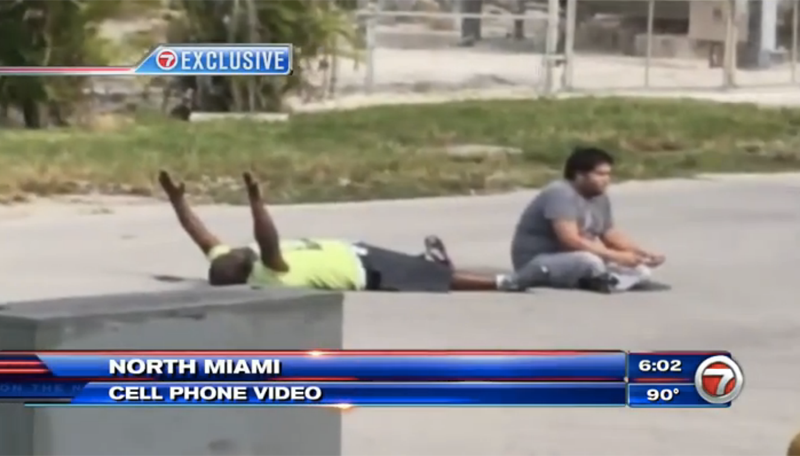Note that Arnaldo's ethnicity has not been identified and I am making assumptions.
News coverage with video, from the local station (ABC 7) that broke it:
My tweetstorm starts here:
Here's how I parse this incident.Cops shoot black therapist lying on ground with hands up, helping Latino autistic man with truck in his hands. https://t.co/j3ie0t36TM— David M. Perry (@Lollardfish) July 21, 2016
1. "Someone" calls police because there's a big Latino guy with a gun contemplating suicide.
But the man was in fact just out in the street with a toy train.
2. Kinsey, a mental health professional, knows this is potentially a deadly situation for the autistic man, because a) police are likely to perceive brown-skinned people (especially but not exclusively) with disabilities as not complying properly in the face of police commands* and b) police are trained to take non-compliance as a threat. So he goes to his client and lays down on his back, raising his arms in the air, both as a signal to the officer AND as a way to show Arnaldo** what to do to survive this.
*Sentence edited lightly for clarity that this is about police perceptions. 7/21 8:20 PM CST.
** Correction: The individual's name was widely reported as Rinaldo, but is now reported as Arnaldo Rios. Changed in this and previous posts.
But also the officer comes in loaded with stigma that people with disabilities are unpredictable and dangerous, likely to lash out.
3. And then the officer shoots Kinsey. Kinsey asks why and the officer says he didn't know, and that's likely to provide some legal accountability in this rare case, as the officer won't be able to retroactively claim he felt reasonably threatened (esp with video and audio).
And then what lessons will we learn? Unless this is a pathway to reconsider compliance-based policing as a norm, nothing will change except for getting one officer off the street.
4. After shooting him, Kinsey was put in handcuffs. Why? I have no idea - is it policy to put people you accidentally shoot in handcuffs to see if later you can construct a scenario in which shooting him was reasonable? Here's where the "threat" argument will go:
Police said the autistic man had something in his hand, but Kinsey's lawyer said it was a toy fire truck and could not be mistaken for a gun.
"It is not silver. It is not shiny. It is not black. It doesn't look like a gun," Napoleon said. "In fact, you can see the autistic guy playing with it."5. The language around autism itself in this is pretty indicative of the ways that Arnaldo was pre-emptively constructed as a dangerous threat:
Clint Bower, who runs the group home, told Local 10 News that Kinsey was shot three times in the leg and that the man he was caring for is non-verbal and has "relatively low function."Function-discourse is a problem. But also this from the cops:
“Arriving officers attempted to negotiate with two men on the scene, one of whom was later identified as suffering from autism,” said North Miami Police in a statement. “At some point during the on-scene negotiation, one of the responding officers discharged his weapon, striking the employee.”Arnaldo does not "suffer" from autism. He was suffering from police officers threatening him.
From Gawker's coverage, here's a still of the video. It shows a black man lying on his back with his arms in the air next to a man dressed in grey clothing, sitting cross-legged. Critically, no one is near them. As near as I can tell, there's no reason for the officers to even have their weapons drawn, though clearly I don't have a sense of the whole tactical situation.
See above for image description
This is not like any case I've seen before in its specifics. I've never read about police shooting the mental health professional who was clearly identifying himself AND telling the officers that the client didn't have a gun. But the generalities, the ways in which the #CultOfCompliance feeds into this incident, those I read about every day.
Follow the "cult of compliance" tag at the bottom of the post for more.

